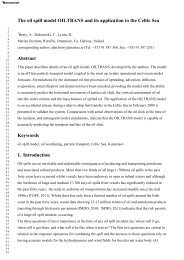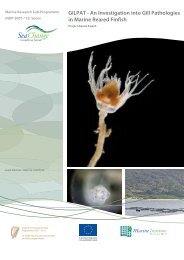Marine Industries Global Market Analysis - Marine Institute
Marine Industries Global Market Analysis - Marine Institute
Marine Industries Global Market Analysis - Marine Institute
You also want an ePaper? Increase the reach of your titles
YUMPU automatically turns print PDFs into web optimized ePapers that Google loves.
82 MARINE INDUSTRIES GLOBAL MARKET ANALYSIS<br />
Figure 13.2: Fishing – World <strong>Market</strong><br />
Source: FAO, Eurostat and Douglas–Westwood<br />
Table 13.1: Fishing – World <strong>Market</strong><br />
1999–03 2004 2005–09<br />
Africa 16401 2583 11550<br />
Asia 201183 31387 140377<br />
Australasia 6100 939 4198<br />
E Europe/FSU 14698 2091 9351<br />
Latin America 48698 7403 33108<br />
Middle East 3020 501 2242<br />
North America 39622 6323 28278<br />
Western Europe 32,313 4,758 21,280<br />
TOTAL (€M) 362,035 55,983 250,386<br />
Source: FAO, Eurostat and Douglas-Westwood<br />
Figure 13.3: Fishing – Regional Segmentation<br />
2005–2009<br />
13.2 WORLD MARKET<br />
The global fishing industry is in decline, while demand has grown dramatically. In the<br />
last 50 years fish consumption per person has doubled. Japan, the US and the EU are<br />
major seafood markets that depend on imports for approximately half of their<br />
consumption. 51 The value of Asian production was greater than any other region in<br />
2004, at over €31 billion. Latin America’s value was nearly a quarter of Asia’s, with<br />
North America not far behind.<br />
World fish consumption has been increasing since the 1960s, due to population<br />
increase and lifestyle factors, such as increased awareness of health benefits. Fishing<br />
technology has advanced over the years to increase catches. As a result of this overfishing<br />
(and pollution) the ocean population of edible fish has decreased by 90%<br />
during the last 50 years.The only way to bridge the gap between reduced capture<br />
fisheries output and increased world demand is through aquaculture.<br />
In 2004 world marine capture fisheries production was at €56 billion. Historically,<br />
production value was €67 billion in 1999, and is forecast to fall to €49 billion by<br />
2009.The world catch tonnage is falling as a result of serious resource problems and<br />
quota restrictions.There are some opportunities offered by new species. However, the<br />
industry faces a future of continuing global decline worldwide until a point of<br />
sustainability can be reached.This decline is forecast at a rate of 2.5% per year in<br />
Euros (0.99% in US Dollars), based on historic trends.<br />
13.3 EUROPEAN MARKET<br />
Europe’s fishing production amounted to 8% of world production in 2004<br />
(€4.7 billion).Within the EU, the UK, Spain, France and Denmark all have<br />
production valued at approximately €500 million each, although within the whole<br />
of Europe Norway is the clear leader, with an output three times the size at<br />
€1.49 billion in 2003.The expansion of the EU member states in 2003 has increased<br />
competition, but also increased the export market for Irish seafood.<br />
A very high percentage of Irish exports are to the EU, although they declined by<br />
10.2% from 2002 to 2003 (excluding fish landings at foreign ports – some of the Irish<br />
quota is landed in Norway where there are better prices and facilities for 24/7<br />
offloading). 52 Meanwhile the domestic market experienced growth. Outside the EU,<br />
a negative effect of the weak dollar has been felt, due to exports from the EU<br />
becoming more expensive for non-EU consumers.<br />
Source: FAO, Eurostat and Douglas–Westwood<br />
51<br />
FAO,‘Projection of World Fishery Production in 2010’.<br />
52<br />
‘BIM Annual Review’, p8, 2003.

















